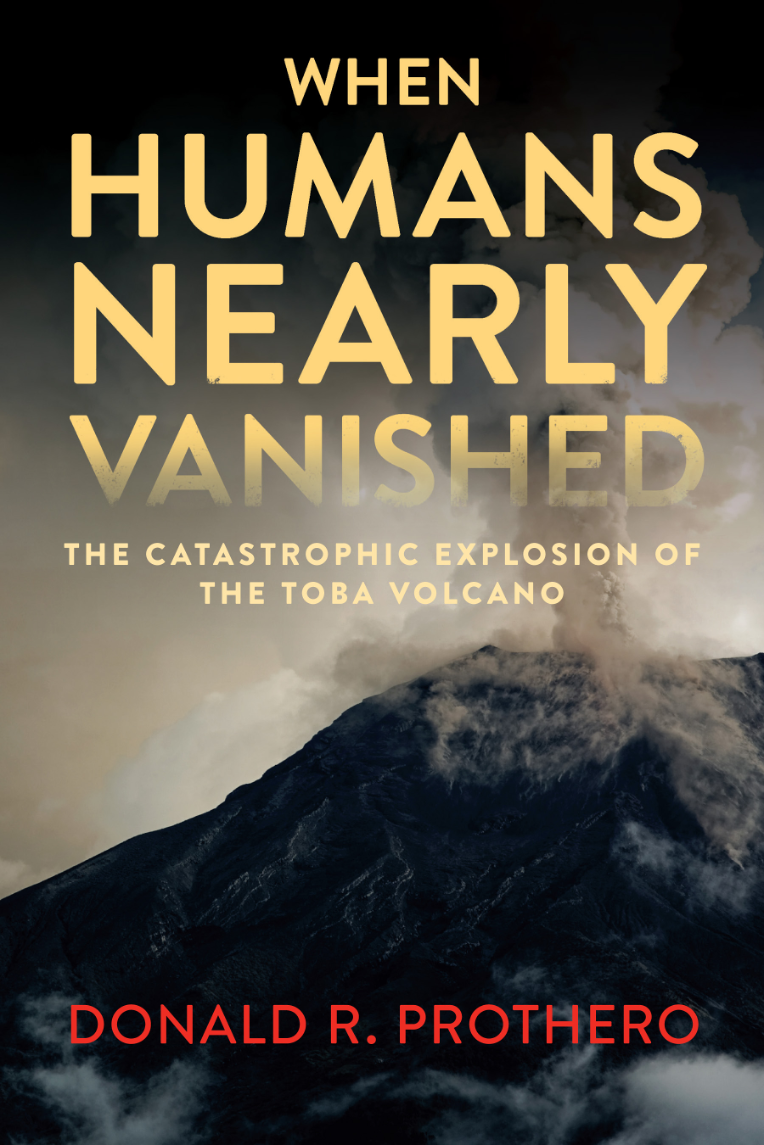Reviewed by Andrej Spiridonov (Vilnius University, Lithuania & Nature Research Centre, Lithuania)

Prothero, D. R. 2018. When Humans Nearly Vanished: The Catastrophic Explosion of the Toba Volcano. Smithsonian Books, 198 pp. ($27.95 cloth.)
In this book, Donald Prothero—palaeontologist and geologist from California State Polytechnic University at Pomona—tackles the mysteries of the colossal super-eruption of the Toba volcano and its effects on human evolution and population bottlenecks in the rest of the biota. The main subject of the book is a singular super-volcano found in the Indonesian island of Sumatra. Currently it can be recognized in the landscape as a huge caldera lake Toba. The subject of volcanoes and super-volcanoes, and their effects on human evolution and more recent history, is an eternal and exciting theme for earth scientists and the general public, and ferment for infinite speculations and night-time stories. The Toba eruption, which happened approximately 74,000 years ago, was one of the latest super-eruptions—defined as an eruption of solid magma volume equivalent larger than 1000 km3 and Volcanic Explosivity Index (VEI) score of 8—and by far the largest during the last several million years. Conspicuously, humans and many other animals show a consistent pattern of decrease in their genetic diversity, which converges to the date of the super-eruption and caldera collapse of the Toba igneous system. Therefore, the theme of the book is of interest to any naturalist as well as laymen.
This relatively concise book is subdivided into nine thematically discrete chapters. The book explores several lines of evidence that converge into a single pattern showing the occurrence of a singular global event that shook the world of the Late Pleistocene. The style of the book is a narrative of historical and personal stories, or historical stories with personal participation, which point to the importance of serendipity (accidental and unforeseen nature) of discovery, and the interconnections of science. There is a chapter on the discovery of huge climatic variability during the Pleistocene, and how it was decoded first as a side effect of military engineering studies of Greenland ice sheets, and later through tireless efforts of generations of scientist. There are a couple chapters on the volcanoes and why some of them erupt mildly and some explosively, with interspersed basics of plate tectonics. There are a couple of chapters on the discovery of the structure of DNA, basics of molecular genetics and the foundations of the molecular clock, and its applications to molecular phylogenies and dating of hominid evolutionary trees. Two more chapters explore the history and current state of human evolutionary studies and the basic patterns of phylogenetics. The final three chapters are focused on the final synthesis (or consilience) of all factual threads: the timing of climatic cooling events, gigantic ash layers, geochemical anomalies in polar ice cores, population bottlenecks of humans and other large vertebrates and even bacterial parasites of humans all converge on approximately one date 74,000 years ago, exactly at the time of the gigantic explosion of Toba.
What is the target audience of the book? I guess, it is any scientifically informed audience. Although for a scientist, this book has too many side excursions, and the density of the material which is directly related to the subject theme—effects of a super-volcano, or more precisely Toba super-volcano eruption, on the climate and biota—could have been condensed without the loss of clarity of explanation, even for a general public into a third-smaller volume. But probably this is a matter of reading taste.
On the more objective matters, the book is often off the mark when the numbers are given, especially regarding quantities of geophysical processes, which are difficult to comprehend on human scales. For example, it was cited several times (sadly without references) that the power of Toba’s explosion was equivalent to 1 million tons of TNT (or 1 Mt). This is equivalent to a large thermonuclear explosion. Is that measure large on the volcanic scale? Nope, this is quite average (in non-statistical terms). The explosion of underwater volcano Hunga Tonga-Hunga Ha'apai that happened last year in the Pacific Ocean is the equivalent of up to 30 Mt (or maybe more) of TNT equivalent1. What happened in its aftermath? Essentially nothing, since this explosion was only 5–6 out of 8 on the volcanic explosivity (VEI) scale, which is approximately logarithmic. The historic eruption of Tambora stratovolcano in 1815 (VEI 7) caused a year without summer in year 1816, and it is thought to have released 33,000 Mt of energy in TNT equivalent (or 15 times the current global nuclear arsenal)2. The “younger Toba tuff” explosion 74,000 years ago was at least an order of magnitude larger—hundreds of thousands to millions of Mt of TNT (VEI 8). The book’s claims for Toba’s explosive power of 1 Mt cited in the book is off by five to six orders of magnitude. Therefore, all precise numbers should be double checked before being cited directly. The content of the book should be seen as an approximate projection of ideas, facts, “semi-facts,” and anecdotes, and not necessarily scientifically citable material. This also has its own merits—unhinged exploration, which is also an important part of the scientific process of generation of future ideas.
Web references:
1. https://www.wionews.com/world/nasa-says-tonga-eruption-equivalent-to-hundreds-of-hiroshimas-447275
2. https://web.archive.org/web/20190429092957/https://www.wired.com/2015/04/tambora-1815-just-big-eruption/

